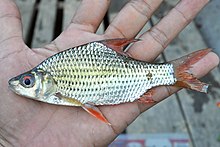The beardless barb (Cyclocheilichthys apogon) is a species of freshwater fish in the family Cyprinidae. It is widespread in Southeast Asia.[1][2] It grows to 25 cm (9.8 in) total length.[2]
| Beardless barb | |
|---|---|

| |
| Cyclocheilichthys apogon from Sambas, West Kalimantan, Indonesia | |
| Scientific classification | |
| Domain: | Eukaryota |
| Kingdom: | Animalia |
| Phylum: | Chordata |
| Class: | Actinopterygii |
| Order: | Cypriniformes |
| Family: | Cyprinidae |
| Genus: | Cyclocheilichthys |
| Species: | C. apogon
|
| Binomial name | |
| Cyclocheilichthys apogon (Valenciennes, 1842)
| |
| Synonyms | |
|
Barbus apogon Valenciennes, 1842 | |
Description
editAs its name suggests, the species does not have a barbel. There is a black blotch at the caudal base and rows of black spots along the scale rows. It grows to 25 cm (9.8 in) total length.[2] A study from Borneo found that 8.1 cm (3.2 in) standard length was reached at the age of two years.[3]
Habitat
editBeardless barb inhabits a range of freshwater environments: rivers, lowland swamps, marshlands (in flooding time), lakes, and reservoirs. It is a migratory species that enters flooded areas during the high-water season.[1][2]
Distribution
editThe species is found in the Mainland Southeast Asia (Myanmar, Thailand, Cambodia, Laos, Vietnam, Malaysia), including the Mekong and Chao Phraya basins, and in the Maritime Southeast Asia (Singapore, Malaysia, Indonesia), including the islands of Sumatra and Borneo.[1]
Utilization
editBeardless barb is present in local food fisheries. It is also present in the ornamental fish trade.[1]
References
edit- ^ a b c d e Lumbantobing, D.; Vidthayanon, C. (2020). "Cyclocheilichthys apogon". IUCN Red List of Threatened Species. 2020: e.T181284A89800549. doi:10.2305/IUCN.UK.2020-2.RLTS.T181284A89800549.en. Retrieved 19 November 2021.
- ^ a b c d Froese, Rainer; Pauly, Daniel (eds.). "Cyclocheilichthys apogon". FishBase. October 2015 version.
- ^ Watson, Dwight J.; Balon, Eugene K. (1985). "Determination of age and growth in stream fishes of northern Borneo". Environmental Biology of Fishes. 13 (1): 59–70. doi:10.1007/BF00004856. S2CID 31749458.
